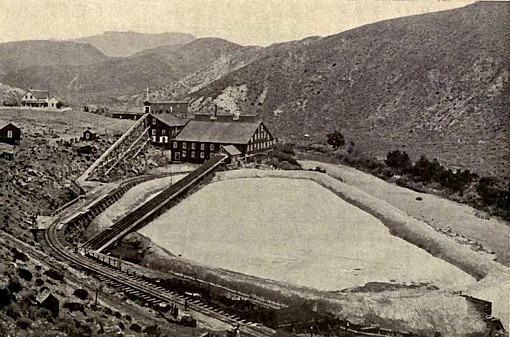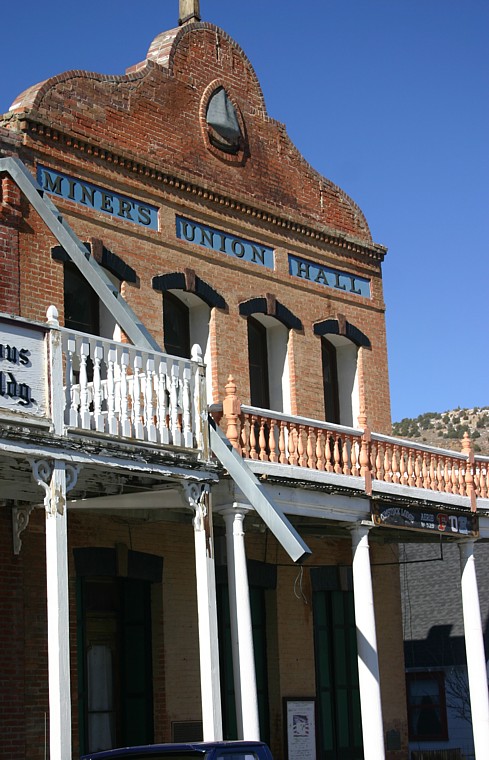There are always some companies in "borrasca" out of luck ; in barren rock while others are in "bonanza" in good luck ; working large bodies of rich silver ore. In a year or two, those who are to-day at work in barren quartz may have a rich body of ore, while those who are to-day in rich ore may in a year or two be delving through barren rock in search of a new bonanza. When a company has for a long time been engaged in the unsuccessful search for ore, their stock very frequently falls to a very low figure and few care to buy it at all, when of a sudden they come upon a great body of rich ore. A rumor of this reaches the surface, and those who have money to invest buy "take in" a few shares at a venture. The officers of the company and their friends in San Francisco who are daily informed by telegraph of all that is going on in the mine begin to quietly gather in all of the stock that they can find, and soon the secret is out and the stock at once bounds upward to a high figure.
Everybody then becomes wild to possess a few shares of the stock. Men who would not touch it when it was selling for a mere trifle, now rush in and pay the highest prices. Some appear never to think of buying stock until they see the whole community excited about it and recklessly bidding for it ; they then rush in and pay the highest figures. It is like piling bricks one upon another till the whole column begins to topple and finally tumbles to the ground. When stock goes down in this way it nearly always goes as far below as it has before been above true merit. Many men who are good judges of mines make large purchases of stock in mines that are in borrasca that are out of ore and appear to be out of luck, biding their time for profit. They have confidence in the mine from the position it occupies on the Comstock lode and from its having had rich bodies of ore above. These, they will contend, were never rained down into the mines from the heavens, but came up from the regions below ; therefore in the regions below, whence came the rich ore already found, there must be more of the same kind. To find it, say they, is a mere matter of time.
In November, 1870, an immense bonanza was found in the Crown Point mine, Gold Hill, at the depth of 1,100 feet. Four months before the discovery of this bonanza, that is, in August of the same year, the stock of the mine was selling at three dollars per share; in May, 1872, the stock was selling at one thousand eight hundred and twenty-five dollars per share. The same bonanza extended south into the Belcher mine, the stock of which was selling for one dollar and fifty cents per share in September, 1870; in April, 1872, it sold for one thousand five hundred and twenty-five dollars per share. At this time, however, there was a grand stock excitement and the stock of many mines in which there was little if any ore sold at very high figures. The masses had come into the market as purchasers and were blindly buying right and left ; they were all industriously engaged in adding bricks to the pile, stocking them up higher and higher, as idiotically strong in the faith that they were building for all time as were the builders of Babel.
Finally down went everything in a grand crash. During this excitement there was an increase in the value of the mines on the Comstock, in about two months, of over forty-five million dollars. All who have visited the lower levels of the mines on the Comstock lode must have observed, even upon the most cursory examination of the ores, the peculiar stratification of which I speak. The chasm in which is formed the Comstock lode was doubtless at one time a seething caldron, and at the great depths now attained, not only great quantities of hot water are found, but the rock itself is in many places sufficiently hot to be almost painful to the naked hand. The course or " strike " of the Comstock vein is a little east of the magnetic meridian, about north twenty-five degrees east. The lode crops out in several places along the face of Mount Davidson, throwing up huge piles of quartz at intervals of from three hundred to five hundred or one thousand yards, as it takes its course southward across the " Divide," and through and beyond Gold Hill ; also, to the northward, in the direction of Cedar Hill and Seven-mile Canon. When the ledge crops out it has a first or false dip to the west, but after being followed down it becomes straight, then turns, and takes its regular dip to the east at an angle of from thirty-five to fifty degrees.
In the Ophir, when the true dip was first discovered, the vein turned to the east at the depth of three hundred and thirty feet. The croppings of the vein being above and to the west of Virginia City, this eastern dip carries it under the whole length and breadth of the town, and it also passes under the town of Gold Hill, a mile further south in the same way. The lead follows the curved outlines of the hills on the surface, swinging in at the ravines and bearing out on the points of the ridges, but as depth is attained it will doubtless be found to straighten in the direction of its present general course. The only gangue of the vein is quartz, though, in places, there are found detached patches and masses of gypsum and carbonate of lime. The ore contains native gold, native silver, sulfide of silver (acanthite), stephanite, chloride of silver, some rich galena and antimony, and a few rare forms of silver in small quantities; also, mingled with the whole mass of the ores, iron pyrites, chalcopyrites, sphalerite, and a few other minerals.
The early miners began the work of opening their claims along the Comstock by sinking shafts on the croppings and by running short tunnels to pass under these croppings and tap the vein at depths varying from two hundred to six or seven hundred feet. The shafts were mere circular holes precisely like an ordinary well, and a common windlass, rope, and bucket, constituted all there was coming under the head of machinery. When more water was encountered than could be hoisted out with a bucket, these early miners were at the "end of their string." Those who were running tunnels, however, were not incommoded by the water they tapped during the progress of their work, as it flowed out as fast as it came in. The Ophir mine was at first worked by means of an incline which followed the dip of the vein to the west. They soon began to be bothered with water and were obliged to set up a small pump, as has already been stated. All of those who had locations on the Comstock, however, were able to find means for the erection of machinery as soon as it was found necessary to use it, though much of the first hoisting and pumping apparatus was too light and was badly arranged. But almost any kind of steam machinery was better than hoisting by the hand-windlass or with the horse-whim.
After starting up with steam hoisting-works, it was not long before a number of companies began to extract ore from the upper series of bonanzas, and these being exhausted, carried their work to lower levels and searched out new bodies of ore. It often happened that when the ore in sight was exhausted, the company was obliged to drift in all directions for a long time before again finding paying ore. In case a level was opened and explored in all parts without finding ore, sinking was resumed in the main shaft, and a new level was opened at a greater depth in the vein. The miners are never discouraged so long as they find a good width of quartz and other vein-matter between the two walls of the lode, as there is then always a chance of finding ore somewhere in the mass. What they do not like, however, is to find the walls coming together "pinching," as they call it. The coming together of the walls pinches out or cuts off the vein ; yet, even at the " pinch," there is always left a seam of clay, or some such sign, by which the lead may be followed until the pinch has been passed and the vein again widens and becomes ore-producing.
Return
to The Nevada Mining Rush Page:
Nevada Gold Rush Mining History


